From Voodoo to GeForce: The Awesome History of 3D Graphics
3dfx Voodoo2
"We do not train to be merciful here. Mercy is for the weak. Here, in the streets in competiton: A man confronts you, he is the enemy. An enemy deserves no mercy." - John Kreese, Cobra Kai Dojo, The Karate Kid
These words may have first been muttered by John Kreese in The Karate Kid, but they could just as easily been attributed to 3dfx. After shellacking the competition with the Voodoo1, mercy was the furthest thing from 3dfx's mind when it released the Voodoo2 in 1998.
Like the original Voodoo, the Voodoo2 once again required a separate 2D videocard for non-3D gaming, only this time the image quality was improved, particularly at higher resolutions (1024x768) where the Voodoo1 struggled. Unlike the original Voodoo, the Voodoo2 added a third chip to the PCB, so there were two TexelFX chips and one PixelFX chip. This gave the new card support for multitexturing, resulting in up to four times better performance in the few games that supported this technique.
Fun Fact: It wasn't Nvidia, but 3dfx who first introduced SLI, albeit a different kind. Called Scan-Line Interleave (as opposed to Nvidia's Scalable Link Interface), each Voodoo2 card in a system would render separate scan lines.
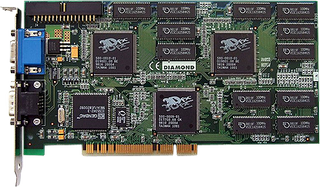
(Image Credit: Wikimedia)
Model: Voodoo2
Date Released: 1998
Interface: AGP/PCI
Shader Model: N/A
DirectX: 3
Manufacturing Process: 0.35 micron
Core Clockspeed: 90MHz
Memory Clockspeed: 90MHz
Memory Bus: 64-bit
Transistors: 4 million
3dfx Voodoo Banshee
Much less menacing than its name implies, the Voodoo Banshee was more about 3dfx proving to the public it could design a single-chip videocard capable of both 2D and 3D rendering, just like the competition had been doing. With faster clockrates than the Voodoo2, the 128-bit Banshee was poised to be the fastest, most flexible videocard on the market, and that presented a problem for 3dfx, who feared the Banshee would cut into sales of the Voodoo2 released just weeks earlier. To prevent that from happening, 3dfx designed the Banshee with only one texturing unit, taking away its ability to support multitexturing.
PC Gamer Newsletter
Sign up to get the best content of the week, and great gaming deals, as picked by the editors.
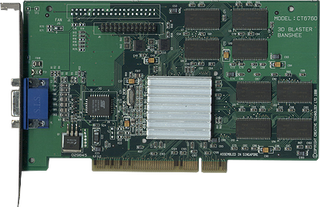
(Image Credit: v3info.de)
Model: Voodoo Banshee
Date Released: 1998
Interface: AGP/PCI
Shader Model: N/A
DirectX: 6
Manufacturing Process: 0.35 micron
Core Clockspeed: 100MHz
Memory Clockspeed: 100MHz
Memory Bus: 128-bit
Transistors: 4 million
Nvidia NV4
In 1998, Nvidia tweaked its existing architecture and released the NV4-based Riva TNT. At a glance, NV4 doesn't appear to be much of an upgrade over NV3. The max amount of memory was doubled to 16MB and clocked a smidgen faster at 110MHz, however the core clockspeed ran 10MHz slower at 90MHz. But what set NV4 apart was the addition of a second pixel pipeline, 32-bit truecolore support, and trilinear filtering.
As good as NV4 was, Nvidia found itself once again trailing behind 3dfx and its proprietary Glide API. Moreover, Voodoo2 owners could link two cards in SLI (as discussed previously) for an even bigger advantage. Plus, 3dfx arguably enjoyed better brand recognition at the time, making it harder to sell Nvidia-branded videocards, although this would be the case for very long.
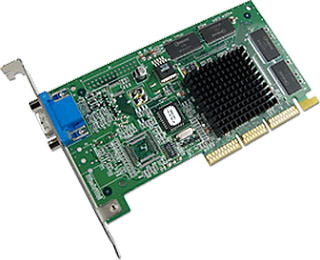
(Image Credit: Nvidia)
Model: Riva TNT
Date Released: 1998
Interface: AGP/PCI
Shader Model: N/A
DirectX: 6
Manufacturing Process: 0.35 micron
Core Clockspeed: 90MHz
Memory Clockspeed: 110MHz
Memory Bus: 128-bit
Transistors: 7 million
ATI Rage 128
Just as the name implies, the Rage 128, released in 1998, touted a 128- bit memory bus, although ATI would release a lower priced version that still maintained a 64-bit design. All of the previous goodies were present and accounted for, such as triangle setup and improved DVD playback, as well as some new tricks, like inverse discrete cosine transform (IDCT) acceleration for even better DVD handling.
For the first time, ATI had a card capable of dual-texturing, outputting two pixels per clock. ATI also implemented a new caching technique, which helped with 3D rendering. A fairly robust card, the Rage 128 support a variety of features, like Alpha blending, texture lighting, hidden surface removal, bump mapping, and plenty more.
ATI would later release the Rage 128 Pro, essentially a 'supercharged' version with improved texture filtering and better video decoding/encoding thanks to the inclusion of a Rage Theater chip, and a slower clocked All-in-Wonder 128, the first of more AIW cards to come with a built-in TV tuner. The AIW 128
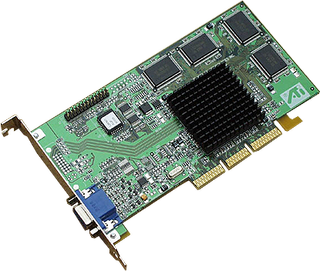
(Image Credit: do-dat.net)
Model: Rage 128
Date Released: 1998
Interface: AGP/PCI
Shader Model: N/A
DirectX: 6
Manufacturing Process: 0.25 micron
Core Clockspeed: 90-103MHz
Memory Clockspeed: 90-103MHz
Memory Bus: 128 -bit
Transistors: 8 million

(Image Credit: ixbt.com)
Model: Rage 128 Pro
Date Released: 1999
Interface: AGP/PCI
Shader Model: N/A
DirectX: 6
Manufacturing Process: 0.25 micron
Core Clockspeed: 125MHz
Memory Clockspeed: 143MHz
Memory Bus: 128-bit
Transistors: 8 million

(Image Credit: firingsquad.com)
Model: All-in-Wonder 128
Date Released: 1999
Interface: AGP/PCI
Shader Model: N/A
DirectX: 6
Manufacturing Process: 0.25 micron
Core Clockspeed: 90MHz
Memory Clockspeed: 90MHz
Memory Bus: 128-bit
Transistors: 8 million
ATI Rage Fury MAXX
Just two months after the Rage 128 Pro came to market, ATI followed suit with the Rage Fury MAXX, a graphics card with two processing engines. Similar in concept to 3dfx's Scan-Line Interleave (SLI) technology, the MAXX differed because not only was this a single-card solution, but because it took a slightly more efficient approach to rendering a scene.
OpenGL and Direct3D were both supported on the Fury MAXX, and the 64MB of onboard memory was overkill for the time, even when split between the two rendering chips. However, the card was hampered by a lack of hardware Transform & Lighting (T&L), which would become a bigger issue as time went on.
ATI would also release a version with an integrated TV tuner, the All-in-Wonder 128, marking the first AIW card of more to come. This first version used the same Rage 128 chipset
Fun Fact: Only during full-screen 3D gaming would the second processing engine kick in. Otherwise, it would lay dormant for both 2D and windowed 3D tasks.

(Image Credit: hothardware.com)
Model: Rage Fury MAXX
Date Released: 1999
Interface: AGP
Shader Model: N/A
DirectX: 7
Manufacturing Process: 0.125 micron
Core Clockspeed: 125MHz
Memory Clockspeed: 143MHz
Memory Bus: 128-bit
Transistors: 8 million (x2)
ATI Rage Mobility
ATI didn't just concentrate on the desktop, it also took aim at the mobile market. Just about every Rage chipset also came in mobile form, starting with the Rage II-based Rage LT in November, 1996. This would continue up until late 1999 when ATI released the Rage Mobility M4, a mobile chip built around the Rage 128 Pro architecture and the last Rage-based mobile GPU. The Mobility moniker lives on to this day culminating the Mobility Radeon HD 4870.
S3 Savage 4
Because the Savage 3D wasn't a bad design, but one that merely lacked polish, S3 continued on with development of the core chipset and several tweaks later, the Savage 4 was born in 1999. Single-pass multi-texturing became part of the package, as did both AGP 2X and 4X support. And in a nod towards forward thinking, some Savage 4 cards came with a DVI port to accommodate LCD panels, which had not yet become a real threat to CRTs.
Sketchy drivers continued to rear their ugly heads, and once again, performance lagged behind the competition, although not necessarily by accident. With the Savage 4, S3 took aim at the budget crowd where it could offer serviceable 2D and 3D performance for a lower price than the higher end cards of the time.
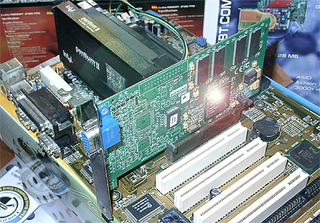
(Image Credit: ixbt.com)
Model: Savage 4
Date Released: 1999
Interface: AGP
Shader Model: N/A
DirectX: 6
Manufacturing Process: 0.25 micron
Core Clockspeed: 110MHz
Memory Clockspeed: 125MHz
Memory Bus: 64-bit

(Image Credit: Palcalova Sbirka)
Model: Savage 4 Pro
Date Released: 1999
Interface: AGP
Shader Model: N/A
DirectX: 6
Manufacturing Process: 0.25 micron
Core Clockspeed: 125MHz
Memory Clockspeed: 125MHz
Memory Bus: 64- bit
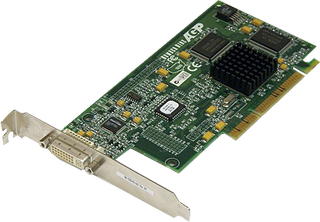
(Image Credit: IBM)
Model: Savage 4 Extreme
Date Released: 1999
Interface: AGP
Shader Model: N/A
DirectX: 6
Manufacturing Process: 0.25 micron
Core Clockspeed: 166MHz
Memory Clockspeed: 166MHz
Memory Bus: 64-bit
S3 Savage 2000
Towards the end of 1999, S3 made one last push into what was fast becoming a competitive 3D graphics market. Facing competition from Matrox, ATI, Nvidia, and 3dfx, S3 acquired Diamond Multimedia as "part of an ongoing strategic plan to return S3 to profitability," and the collaboration gave birth to the Savage 2000.
Featuring 12 million transistors on a 0.18-micron manufacturing process, the Savage 2000 brought its A-game, at least on paper. Onboard hardware Transform & Lighting (T&L), single-pass quad texture blending, 500 million pixel/s fill rate, a 128-bit memory bus, and overclockable memory should have added up to a videocard to be reckoned with. But as was becoming an all too familiar scenario, poorly written drivers continued to hold S3's silicon back from its full potential.
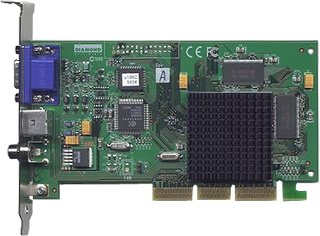
(Image Credit: Tomshardware)
Model: Savage 2000
Date Released: 1999
Interface: AGP
Shader Model: N/A
DirectX: 7
Manufacturing Process: 0.18 micron
Core Clockspeed: 120MHz
Memory Clockspeed: 120MHz
Memory Bus: 128-bit
Next, Nvidia takes the lead with the explosive TNT2 and Geforce
Paul has been playing PC games and raking his knuckles on computer hardware since the Commodore 64. He does not have any tattoos, but thinks it would be cool to get one that reads LOAD"*",8,1. In his off time, he rides motorcycles and wrestles alligators (only one of those is true).
Most Popular



